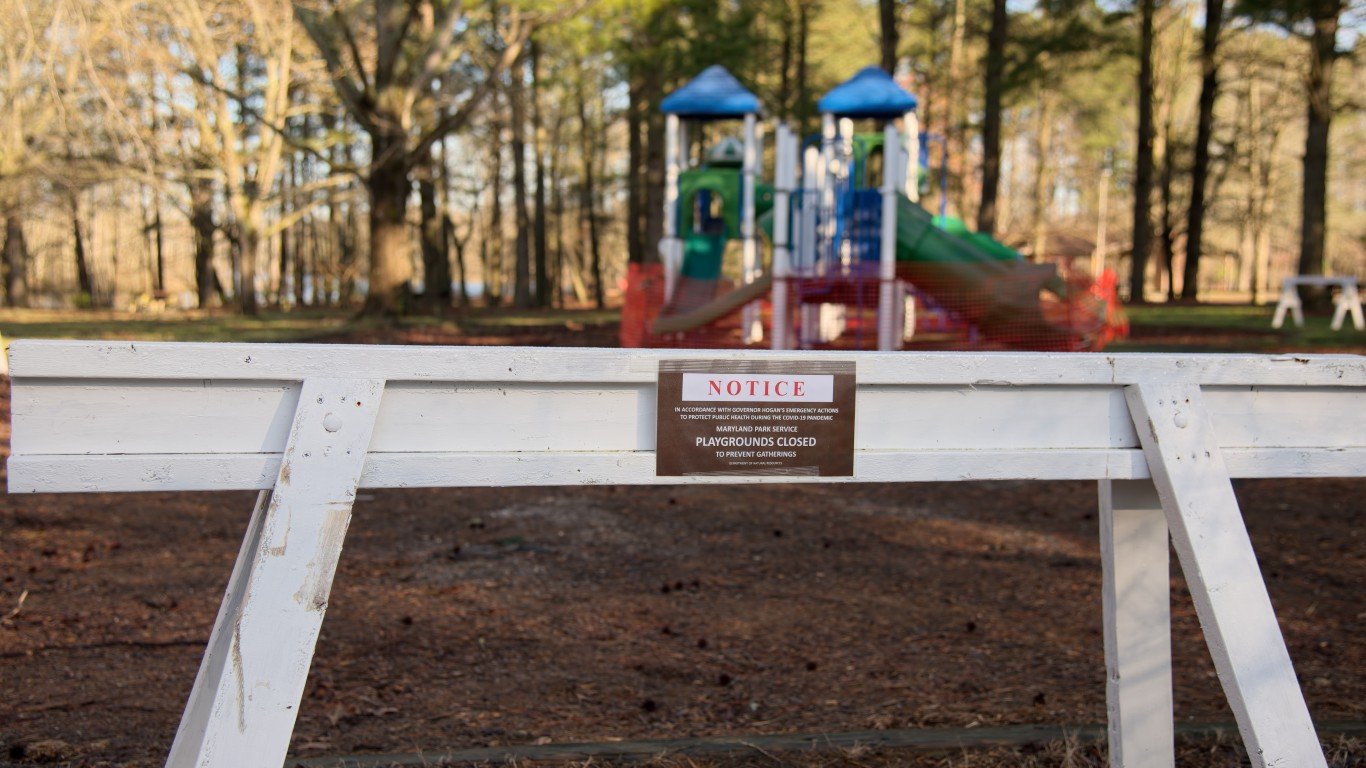

The U.S. is rapidly approaching 2 million confirmed cases of COVID-19, but as a whole, the country has likely seen the worst of the pandemic — for now. There are a handful of states, however, in which the outbreak will likely not peak until later in June or even July.
24/7 Wall St. reviewed projections from the Institute for Health Metrics and Evaluation on the estimated peak COVID-19 dates in every state, both in terms of the total number of estimated active infections and the total number of hospital beds needed to treat COVID-19 patients. The projections are as of June 1, except for Connecticut and New Hampshire, for which the projections are for May 31.
The numbers of daily new infections per 100,000 residents differ widely across the country. In Northeastern states like New York and New Jersey, which likely already peaked as the early epicenter of the outbreak in March, the numbers of new infections have been declining dramatically over the past two weeks. Despite these declines, these states still report more confirmed cases per capita than almost all others. These are the states where coronavirus is growing the fastest.
As the peak has likely passed in most parts of the country, states have begun to allow businesses like restaurants, retailers, and more to reopen. Leaders must weigh the risks of reopening too soon with the harsh economic reality in the wake of the pandemic. Efforts to contain the virus have decimated the economies of every state, and extending closures will continue to adversely affect businesses and workers. Nearly 40 million Americans have lost their jobs since the outbreak began, and in some states unemployment claims since mid-March have amounted to over 40% of the workforce (as measured before the pandemic). These are each state’s unemployment claims since coronavirus shut down the economy.
Click here to see COVID-19 peak dates for every state.
Alabama
> Est. peak date, total active infections: 4/19/2020 (est. 1,692 active infections)
> Est. peak date, beds needed: 5/6/2020 (est. 355 beds needed)
> Date of first known case: 3/13/2020
> Cumulative confirmed COVID-19 cases as of June 1: 371 per 100,000 people — 22nd most (total: 18,150)
> COVID-19 related deaths as of June 1: 10.0 per 100,000 people — 23rd most (total: 644)
> Tests completed as of June 1: 4,601 per 100,000 people — 22nd fewest (total: 224,892)
[in-text-ad]
Alaska
> Est. peak date, total active infections: 3/18/2020 (est. 88 active infections)
> Est. peak date, beds needed: N/A
> Date of first known case: 3/12/2020
> Cumulative confirmed COVID-19 cases as of June 1: 63 per 100,000 people — 3rd fewest (total: 467)
> COVID-19 related deaths as of June 1: 10.0 per 100,000 people — 2nd fewest (total: 10)
> Tests completed as of June 1: 7,348 per 100,000 people — 8th most (total: 54,190)
Arizona
> Est. peak date, total active infections: 4/16/2020 (est. 2,386 active infections)
> Est. peak date, beds needed: 7/3/2020 (est. 808 beds needed)
> Date of first known case: 1/26/2020
> Cumulative confirmed COVID-19 cases as of June 1: 281 per 100,000 people — 18th fewest (total: 20,123)
> COVID-19 related deaths as of June 1: 10.0 per 100,000 people — 24th most (total: 917)
> Tests completed as of June 1: 3,180 per 100,000 people — 3rd fewest (total: 228,070)
Arkansas
> Est. peak date, total active infections: 4/14/2020 (est. 317 active infections)
> Est. peak date, beds needed: 7/22/2020 (est. 166 beds needed)
> Date of first known case: 3/11/2020
> Cumulative confirmed COVID-19 cases as of June 1: 247 per 100,000 people — 15th fewest (total: 7,443)
> COVID-19 related deaths as of June 1: 10.0 per 100,000 people — 8th fewest (total: 133)
> Tests completed as of June 1: 4,421 per 100,000 people — 19th fewest (total: 133,236)
[in-text-ad-2]

California
> Est. peak date, total active infections: 4/8/2020 (est. 10,236 active infections)
> Est. peak date, beds needed: 6/19/2020 (est. 4,045 beds needed)
> Date of first known case: 1/25/2020
> Cumulative confirmed COVID-19 cases as of June 1: 286 per 100,000 people — 20th fewest (total: 113,006)
> COVID-19 related deaths as of June 1: 10.0 per 100,000 people — 23rd fewest (total: 4,251)
> Tests completed as of June 1: 5,088 per 100,000 people — 22nd most (total: 2,012,583)

Colorado
> Est. peak date, total active infections: 4/2/2020 (est. 3,909 active infections)
> Est. peak date, beds needed: 4/19/2020 (est. 796 beds needed)
> Date of first known case: 3/5/2020
> Cumulative confirmed COVID-19 cases as of June 1: 467 per 100,000 people — 18th most (total: 26,577)
> COVID-19 related deaths as of June 1: 10.0 per 100,000 people — 13th most (total: 1,458)
> Tests completed as of June 1: 3,302 per 100,000 people — 6th fewest (total: 188,069)
[in-text-ad]
Connecticut
> Est. peak date, total active infections: 4/5/2020 (est. 10,932 active infections)
> Est. peak date, beds needed: 4/20/2020 (est. 3,097 beds needed)
> Date of first known case: 3/8/2020
> Cumulative confirmed COVID-19 cases as of June 1: 1,196 per 100,000 people — 5th most (total: 42,743)
> COVID-19 related deaths as of June 1: 10.0 per 100,000 people — 3rd most (total: 3,970)
> Tests completed as of June 1: 7,258 per 100,000 people — 9th most (total: 259,320)

Delaware
> Est. peak date, total active infections: 4/17/2020 (est. 978 active infections)
> Est. peak date, beds needed: 5/5/2020 (est. 288 beds needed)
> Date of first known case: 3/11/2020
> Cumulative confirmed COVID-19 cases as of June 1: 993 per 100,000 people — 6th most (total: 9,605)
> COVID-19 related deaths as of June 1: 10.0 per 100,000 people — 11th most (total: 368)
> Tests completed as of June 1: 6,457 per 100,000 people — 13th most (total: 62,447)

Florida
> Est. peak date, total active infections: 4/1/2020 (est. 4,674 active infections)
> Est. peak date, beds needed: 4/18/2020 (est. 1,493 beds needed)
> Date of first known case: 3/1/2020
> Cumulative confirmed COVID-19 cases as of June 1: 267 per 100,000 people — 17th fewest (total: 56,830)
> COVID-19 related deaths as of June 1: 10.0 per 100,000 people — 24th fewest (total: 2,460)
> Tests completed as of June 1: 4,889 per 100,000 people — 24th most (total: 1,041,318)
[in-text-ad-2]

Georgia
> Est. peak date, total active infections: 4/1/2020 (est. 5,222 active infections)
> Est. peak date, beds needed: 4/18/2020 (est. 1,373 beds needed)
> Date of first known case: 3/2/2020
> Cumulative confirmed COVID-19 cases as of June 1: 455 per 100,000 people — 19th most (total: 47,916)
> COVID-19 related deaths as of June 1: 10.0 per 100,000 people — 15th most (total: 2,089)
> Tests completed as of June 1: 4,483 per 100,000 people — 20th fewest (total: 471,631)
Hawaii
> Est. peak date, total active infections: 3/27/2020 (est. 76 active infections)
> Est. peak date, beds needed: 4/14/2020 (est. 26 beds needed)
> Date of first known case: 3/6/2020
> Cumulative confirmed COVID-19 cases as of June 1: 46 per 100,000 people — the fewest (total: 652)
> COVID-19 related deaths as of June 1: 10.0 per 100,000 people — the fewest (total: 17)
> Tests completed as of June 1: 3,923 per 100,000 people — 14th fewest (total: 55,719)
[in-text-ad]

Idaho
> Est. peak date, total active infections: 3/27/2020 (est. 311 active infections)
> Est. peak date, beds needed: 4/19/2020 (est. 69 beds needed)
> Date of first known case: 3/13/2020
> Cumulative confirmed COVID-19 cases as of June 1: 162 per 100,000 people — 8th fewest (total: 2,839)
> COVID-19 related deaths as of June 1: 10.0 per 100,000 people — 9th fewest (total: 82)
> Tests completed as of June 1: 2,647 per 100,000 people — the fewest (total: 46,436)

Illinois
> Est. peak date, total active infections: 4/25/2020 (est. 13,243 active infections)
> Est. peak date, beds needed: 5/9/2020 (est. 3,576 beds needed)
> Date of first known case: 1/24/2020
> Cumulative confirmed COVID-19 cases as of June 1: 952 per 100,000 people — 7th most (total: 121,234)
> COVID-19 related deaths as of June 1: 10.0 per 100,000 people — 9th most (total: 5,412)
> Tests completed as of June 1: 7,207 per 100,000 people — 10th most (total: 918,273)
Indiana
> Est. peak date, total active infections: 4/5/2020 (est. 4,933 active infections)
> Est. peak date, beds needed: 4/23/2020 (est. 1,324 beds needed)
> Date of first known case: 3/6/2020
> Cumulative confirmed COVID-19 cases as of June 1: 520 per 100,000 people — 17th most (total: 34,830)
> COVID-19 related deaths as of June 1: 10.0 per 100,000 people — 12th most (total: 1,976)
> Tests completed as of June 1: 3,973 per 100,000 people — 15th fewest (total: 265,896)
[in-text-ad-2]

Iowa
> Est. peak date, total active infections: 5/8/2020 (est. 1,637 active infections)
> Est. peak date, beds needed: 6/4/2020 (est. 591 beds needed)
> Date of first known case: 3/8/2020
> Cumulative confirmed COVID-19 cases as of June 1: 624 per 100,000 people — 11th most (total: 19,688)
> COVID-19 related deaths as of June 1: 10.0 per 100,000 people — 20th most (total: 538)
> Tests completed as of June 1: 5,047 per 100,000 people — 23rd most (total: 159,292)
Kansas
> Est. peak date, total active infections: 3/26/2020 (est. 696 active infections)
> Est. peak date, beds needed: 4/13/2020 (est. 154 beds needed)
> Date of first known case: 3/7/2020
> Cumulative confirmed COVID-19 cases as of June 1: 334 per 100,000 people — 25th fewest (total: 9,719)
> COVID-19 related deaths as of June 1: 10.0 per 100,000 people — 14th fewest (total: 208)
> Tests completed as of June 1: 3,261 per 100,000 people — 5th fewest (total: 94,949)
[in-text-ad]
Kentucky
> Est. peak date, total active infections: 3/27/2020 (est. 1,324 active infections)
> Est. peak date, beds needed: 4/14/2020 (est. 347 beds needed)
> Date of first known case: 3/6/2020
> Cumulative confirmed COVID-19 cases as of June 1: 225 per 100,000 people — 12th fewest (total: 10,046)
> COVID-19 related deaths as of June 1: 10.0 per 100,000 people — 20th fewest (total: 439)
> Tests completed as of June 1: 4,831 per 100,000 people — 25th most (total: 215,853)
Louisiana
> Est. peak date, total active infections: 3/24/2020 (est. 7,882 active infections)
> Est. peak date, beds needed: 4/12/2020 (est. 2,060 beds needed)
> Date of first known case: 3/9/2020
> Cumulative confirmed COVID-19 cases as of June 1: 866 per 100,000 people — 9th most (total: 40,341)
> COVID-19 related deaths as of June 1: 10.0 per 100,000 people — 6th most (total: 2,690)
> Tests completed as of June 1: 8,313 per 100,000 people — 7th most (total: 387,370)
Maine
> Est. peak date, total active infections: 3/31/2020 (est. 204 active infections)
> Est. peak date, beds needed: 4/22/2020 (est. 70 beds needed)
> Date of first known case: 3/12/2020
> Cumulative confirmed COVID-19 cases as of June 1: 176 per 100,000 people — 10th fewest (total: 2,349)
> COVID-19 related deaths as of June 1: 10.0 per 100,000 people — 12th fewest (total: 89)
> Tests completed as of June 1: 3,742 per 100,000 people — 11th fewest (total: 50,078)
[in-text-ad-2]

Maryland
> Est. peak date, total active infections: 4/6/2020 (est. 6,509 active infections)
> Est. peak date, beds needed: 4/26/2020 (est. 2,332 beds needed)
> Date of first known case: 3/5/2020
> Cumulative confirmed COVID-19 cases as of June 1: 883 per 100,000 people — 8th most (total: 53,327)
> COVID-19 related deaths as of June 1: 10.0 per 100,000 people — 10th most (total: 2,552)
> Tests completed as of June 1: 5,109 per 100,000 people — 21st most (total: 308,730)
Massachusetts
> Est. peak date, total active infections: 4/7/2020 (est. 20,125 active infections)
> Est. peak date, beds needed: 4/24/2020 (est. 2,647 beds needed)
> Date of first known case: 2/1/2020
> Cumulative confirmed COVID-19 cases as of June 1: 1,460 per 100,000 people — 3rd most (total: 100,805)
> COVID-19 related deaths as of June 1: 10.0 per 100,000 people — 4th most (total: 7,035)
> Tests completed as of June 1: 8,692 per 100,000 people — 6th most (total: 599,919)
[in-text-ad]
Michigan
> Est. peak date, total active infections: 3/27/2020 (est. 15,179 active infections)
> Est. peak date, beds needed: 4/15/2020 (est. 4,346 beds needed)
> Date of first known case: 3/10/2020
> Cumulative confirmed COVID-19 cases as of June 1: 576 per 100,000 people — 12th most (total: 57,532)
> COVID-19 related deaths as of June 1: 10.0 per 100,000 people — 7th most (total: 5,516)
> Tests completed as of June 1: 4,701 per 100,000 people — 24th fewest (total: 469,915)
Minnesota
> Est. peak date, total active infections: 4/20/2020 (est. 2,847 active infections)
> Est. peak date, beds needed: 5/31/2020 (est. 658 beds needed)
> Date of first known case: 3/6/2020
> Cumulative confirmed COVID-19 cases as of June 1: 449 per 100,000 people — 20th most (total: 25,208)
> COVID-19 related deaths as of June 1: 10.0 per 100,000 people — 17th most (total: 1,050)
> Tests completed as of June 1: 4,555 per 100,000 people — 21st fewest (total: 255,592)
Mississippi
> Est. peak date, total active infections: 4/30/2020 (est. 1,871 active infections)
> Est. peak date, beds needed: 5/17/2020 (est. 514 beds needed)
> Date of first known case: 3/11/2020
> Cumulative confirmed COVID-19 cases as of June 1: 527 per 100,000 people — 16th most (total: 15,752)
> COVID-19 related deaths as of June 1: 10.0 per 100,000 people — 14th most (total: 739)
> Tests completed as of June 1: 5,902 per 100,000 people — 14th most (total: 176,254)
[in-text-ad-2]

Missouri
> Est. peak date, total active infections: 4/14/2020 (est. 1,757 active infections)
> Est. peak date, beds needed: 5/3/2020 (est. 492 beds needed)
> Date of first known case: 3/7/2020
> Cumulative confirmed COVID-19 cases as of June 1: 218 per 100,000 people — 11th fewest (total: 13,327)
> COVID-19 related deaths as of June 1: 10.0 per 100,000 people — 25th fewest (total: 773)
> Tests completed as of June 1: 3,255 per 100,000 people — 4th fewest (total: 199,435)
Montana
> Est. peak date, total active infections: 3/12/2020 (est. 98 active infections)
> Est. peak date, beds needed: 4/18/2020 (est. 29 beds needed)
> Date of first known case: 3/13/2020
> Cumulative confirmed COVID-19 cases as of June 1: 49 per 100,000 people — 2nd fewest (total: 519)
> COVID-19 related deaths as of June 1: 10.0 per 100,000 people — 3rd fewest (total: 17)
> Tests completed as of June 1: 3,827 per 100,000 people — 13th fewest (total: 40,657)
[in-text-ad]
Nebraska
> Est. peak date, total active infections: 5/8/2020 (est. 582 active infections)
> Est. peak date, beds needed: 6/3/2020 (est. 163 beds needed)
> Date of first known case: 2/17/2020
> Cumulative confirmed COVID-19 cases as of June 1: 744 per 100,000 people — 10th most (total: 14,345)
> COVID-19 related deaths as of June 1: 10.0 per 100,000 people — 19th fewest (total: 178)
> Tests completed as of June 1: 5,524 per 100,000 people — 16th most (total: 106,570)

Nevada
> Est. peak date, total active infections: 3/25/2020 (est. 1,132 active infections)
> Est. peak date, beds needed: 4/23/2020 (est. 287 beds needed)
> Date of first known case: 3/5/2020
> Cumulative confirmed COVID-19 cases as of June 1: 264 per 100,000 people — 16th fewest (total: 8,000)
> COVID-19 related deaths as of June 1: 10.0 per 100,000 people — 25th most (total: 387)
> Tests completed as of June 1: 3,313 per 100,000 people — 7th fewest (total: 100,540)
New Hampshire
> Est. peak date, total active infections: 4/29/2020 (est. 740 active infections)
> Est. peak date, beds needed: 5/23/2020 (est. 253 beds needed)
> Date of first known case: 3/2/2020
> Cumulative confirmed COVID-19 cases as of June 1: 345 per 100,000 people — 24th most (total: 4,685)
> COVID-19 related deaths as of June 1: 10.0 per 100,000 people — 18th most (total: 245)
> Tests completed as of June 1: 5,481 per 100,000 people — 18th most (total: 74,344)
[in-text-ad-2]

New Jersey
> Est. peak date, total active infections: 3/31/2020 (est. 32,287 active infections)
> Est. peak date, beds needed: 4/18/2020 (est. 8,860 beds needed)
> Date of first known case: 3/4/2020
> Cumulative confirmed COVID-19 cases as of June 1: 1,806 per 100,000 people — 2nd most (total: 160,918)
> COVID-19 related deaths as of June 1: 10.0 per 100,000 people — the most (total: 11,721)
> Tests completed as of June 1: 8,931 per 100,000 people — 5th most (total: 795,600)
New Mexico
> Est. peak date, total active infections: 4/17/2020 (est. 983 active infections)
> Est. peak date, beds needed: 5/14/2020 (est. 264 beds needed)
> Date of first known case: 3/11/2020
> Cumulative confirmed COVID-19 cases as of June 1: 372 per 100,000 people — 21st most (total: 7,800)
> COVID-19 related deaths as of June 1: 10.0 per 100,000 people — 19th most (total: 362)
> Tests completed as of June 1: 9,693 per 100,000 people — 3rd most (total: 203,115)
[in-text-ad]

New York
> Est. peak date, total active infections: 3/25/2020 (est. 108,815 active infections)
> Est. peak date, beds needed: 4/10/2020 (est. 19,593 beds needed)
> Date of first known case: 3/1/2020
> Cumulative confirmed COVID-19 cases as of June 1: 1,902 per 100,000 people — the most (total: 371,711)
> COVID-19 related deaths as of June 1: 10.0 per 100,000 people — 2nd most (total: 23,959)
> Tests completed as of June 1: 10,816 per 100,000 people — 2nd most (total: 2,113,777)
North Carolina
> Est. peak date, total active infections: 4/6/2020 (est. 2,132 active infections)
> Est. peak date, beds needed: 5/30/2020 (est. 598 beds needed)
> Date of first known case: 3/3/2020
> Cumulative confirmed COVID-19 cases as of June 1: 282 per 100,000 people — 19th fewest (total: 29,263)
> COVID-19 related deaths as of June 1: 10.0 per 100,000 people — 17th fewest (total: 898)
> Tests completed as of June 1: 4,063 per 100,000 people — 16th fewest (total: 421,908)
North Dakota
> Est. peak date, total active infections: 4/22/2020 (est. 171 active infections)
> Est. peak date, beds needed: 5/12/2020 (est. 48 beds needed)
> Date of first known case: 3/11/2020
> Cumulative confirmed COVID-19 cases as of June 1: 345 per 100,000 people — 25th most (total: 2,625)
> COVID-19 related deaths as of June 1: 10.0 per 100,000 people — 15th fewest (total: 61)
> Tests completed as of June 1: 9,644 per 100,000 people — 4th most (total: 73,301)
[in-text-ad-2]
Ohio
> Est. peak date, total active infections: 4/20/2020 (est. 4,752 active infections)
> Est. peak date, beds needed: 5/23/2020 (est. 1,425 beds needed)
> Date of first known case: 3/9/2020
> Cumulative confirmed COVID-19 cases as of June 1: 308 per 100,000 people — 22nd fewest (total: 35,984)
> COVID-19 related deaths as of June 1: 10.0 per 100,000 people — 16th most (total: 2,206)
> Tests completed as of June 1: 3,405 per 100,000 people — 9th fewest (total: 398,066)
Oklahoma
> Est. peak date, total active infections: 3/29/2020 (est. 915 active infections)
> Est. peak date, beds needed: 4/19/2020 (est. 236 beds needed)
> Date of first known case: 3/6/2020
> Cumulative confirmed COVID-19 cases as of June 1: 167 per 100,000 people — 9th fewest (total: 6,573)
> COVID-19 related deaths as of June 1: 10.0 per 100,000 people — 16th fewest (total: 334)
> Tests completed as of June 1: 5,227 per 100,000 people — 19th most (total: 206,116)
[in-text-ad]

Oregon
> Est. peak date, total active infections: 4/5/2020 (est. 362 active infections)
> Est. peak date, beds needed: 4/30/2020 (est. 110 beds needed)
> Date of first known case: 2/28/2020
> Cumulative confirmed COVID-19 cases as of June 1: 103 per 100,000 people — 4th fewest (total: 4,302)
> COVID-19 related deaths as of June 1: 10.0 per 100,000 people — 6th fewest (total: 154)
> Tests completed as of June 1: 3,138 per 100,000 people — 2nd fewest (total: 131,508)

Pennsylvania
> Est. peak date, total active infections: 4/11/2020 (est. 13,278 active infections)
> Est. peak date, beds needed: 4/29/2020 (est. 3,872 beds needed)
> Date of first known case: 3/6/2020
> Cumulative confirmed COVID-19 cases as of June 1: 564 per 100,000 people — 14th most (total: 72,282)
> COVID-19 related deaths as of June 1: 10.0 per 100,000 people — 8th most (total: 5,567)
> Tests completed as of June 1: 3,605 per 100,000 people — 10th fewest (total: 461,713)
Rhode Island
> Est. peak date, total active infections: 5/5/2020 (est. 1,650 active infections)
> Est. peak date, beds needed: 5/22/2020 (est. 471 beds needed)
> Date of first known case: 3/1/2020
> Cumulative confirmed COVID-19 cases as of June 1: 1,418 per 100,000 people — 4th most (total: 14,991)
> COVID-19 related deaths as of June 1: 10.0 per 100,000 people — 5th most (total: 720)
> Tests completed as of June 1: 14,833 per 100,000 people — the most (total: 156,835)
[in-text-ad-2]
South Carolina
> Est. peak date, total active infections: 4/15/2020 (est. 1,203 active infections)
> Est. peak date, beds needed: 5/5/2020 (est. 336 beds needed)
> Date of first known case: 3/6/2020
> Cumulative confirmed COVID-19 cases as of June 1: 239 per 100,000 people — 14th fewest (total: 12,148)
> COVID-19 related deaths as of June 1: 10.0 per 100,000 people — 21st fewest (total: 500)
> Tests completed as of June 1: 4,147 per 100,000 people — 17th fewest (total: 210,826)

South Dakota
> Est. peak date, total active infections: 4/21/2020 (est. 234 active infections)
> Est. peak date, beds needed: 5/10/2020 (est. 62 beds needed)
> Date of first known case: 3/10/2020
> Cumulative confirmed COVID-19 cases as of June 1: 571 per 100,000 people — 13th most (total: 5,034)
> COVID-19 related deaths as of June 1: 10.0 per 100,000 people — 13th fewest (total: 62)
> Tests completed as of June 1: 5,176 per 100,000 people — 20th most (total: 45,661)
[in-text-ad]

Tennessee
> Est. peak date, total active infections: 3/23/2020 (est. 937 active infections)
> Est. peak date, beds needed: 4/10/2020 (est. 218 beds needed)
> Date of first known case: 3/5/2020
> Cumulative confirmed COVID-19 cases as of June 1: 348 per 100,000 people — 23rd most (total: 23,554)
> COVID-19 related deaths as of June 1: 10.0 per 100,000 people — 10th fewest (total: 367)
> Tests completed as of June 1: 6,625 per 100,000 people — 12th most (total: 448,493)
Texas
> Est. peak date, total active infections: 4/26/2020 (est. 4,656 active infections)
> Est. peak date, beds needed: 5/13/2020 (est. 1,121 beds needed)
> Date of first known case: 2/12/2020
> Cumulative confirmed COVID-19 cases as of June 1: 226 per 100,000 people — 13th fewest (total: 64,880)
> COVID-19 related deaths as of June 1: 10.0 per 100,000 people — 11th fewest (total: 1,678)
> Tests completed as of June 1: 3,380 per 100,000 people — 8th fewest (total: 970,031)

Utah
> Est. peak date, total active infections: 6/1/2020 (est. 412 active infections)
> Est. peak date, beds needed: 6/14/2020 (est. 124 beds needed)
> Date of first known case: 2/25/2020
> Cumulative confirmed COVID-19 cases as of June 1: 316 per 100,000 people — 23rd fewest (total: 9,999)
> COVID-19 related deaths as of June 1: 10.0 per 100,000 people — 5th fewest (total: 113)
> Tests completed as of June 1: 6,900 per 100,000 people — 11th most (total: 218,112)
[in-text-ad-2]
Vermont
> Est. peak date, total active infections: 3/17/2020 (est. 156 active infections)
> Est. peak date, beds needed: 4/25/2020 (est. 32 beds needed)
> Date of first known case: 3/7/2020
> Cumulative confirmed COVID-19 cases as of June 1: 157 per 100,000 people — 6th fewest (total: 983)
> COVID-19 related deaths as of June 1: 10.0 per 100,000 people — 18th fewest (total: 55)
> Tests completed as of June 1: 5,640 per 100,000 people — 15th most (total: 35,326)
Virginia
> Est. peak date, total active infections: 4/13/2020 (est. 3,625 active infections)
> Est. peak date, beds needed: 6/2/2020 (est. 1,080 beds needed)
> Date of first known case: 3/7/2020
> Cumulative confirmed COVID-19 cases as of June 1: 533 per 100,000 people — 15th most (total: 45,398)
> COVID-19 related deaths as of June 1: 10.0 per 100,000 people — 21st most (total: 1,392)
> Tests completed as of June 1: 3,787 per 100,000 people — 12th fewest (total: 322,568)
[in-text-ad]

Washington
> Est. peak date, total active infections: 3/24/2020 (est. 2,770 active infections)
> Est. peak date, beds needed: 4/8/2020 (est. 793 beds needed)
> Date of first known case: 1/21/2020
> Cumulative confirmed COVID-19 cases as of June 1: 288 per 100,000 people — 21st fewest (total: 21,702)
> COVID-19 related deaths as of June 1: 10.0 per 100,000 people — 22nd most (total: 1,118)
> Tests completed as of June 1: 4,789 per 100,000 people — 25th fewest (total: 360,899)

West Virginia
> Est. peak date, total active infections: 4/6/2020 (est. 224 active infections)
> Est. peak date, beds needed: 4/30/2020 (est. 64 beds needed)
> Date of first known case: 3/17/2020
> Cumulative confirmed COVID-19 cases as of June 1: 109 per 100,000 people — 5th fewest (total: 1,970)
> COVID-19 related deaths as of June 1: 10.0 per 100,000 people — 7th fewest (total: 76)
> Tests completed as of June 1: 5,524 per 100,000 people — 17th most (total: 99,751)
Wisconsin
> Est. peak date, total active infections: 3/30/2020 (est. 1,312 active infections)
> Est. peak date, beds needed: 4/16/2020 (est. 355 beds needed)
> Date of first known case: 2/5/2020
> Cumulative confirmed COVID-19 cases as of June 1: 319 per 100,000 people — 24th fewest (total: 18,543)
> COVID-19 related deaths as of June 1: 10.0 per 100,000 people — 22nd fewest (total: 595)
> Tests completed as of June 1: 4,681 per 100,000 people — 23rd fewest (total: 272,138)
[in-text-ad-2]
Wyoming
> Est. peak date, total active infections: 5/8/2020 (est. 93 active infections)
> Est. peak date, beds needed: 5/23/2020 (est. 30 beds needed)
> Date of first known case: 3/11/2020
> Cumulative confirmed COVID-19 cases as of June 1: 158 per 100,000 people — 7th fewest (total: 910)
> COVID-19 related deaths as of June 1: 10.0 per 100,000 people — 4th fewest (total: 17)
> Tests completed as of June 1: 4,419 per 100,000 people — 18th fewest (total: 25,531)
Sponsored: Find a Qualified Financial Advisor
Finding a qualified financial advisor doesn’t have to be hard. SmartAsset’s free tool matches you with up to 3 fiduciary financial advisors in your area in 5 minutes. Each advisor has been vetted by SmartAsset and is held to a fiduciary standard to act in your best interests. If you’re ready to be matched with local advisors that can help you achieve your financial goals, get started now.
Thank you for reading! Have some feedback for us?
Contact the 24/7 Wall St. editorial team.





 24/7 Wall St.
24/7 Wall St.







 24/7 Wall St.
24/7 Wall St.









 24/7 Wall St.
24/7 Wall St.









